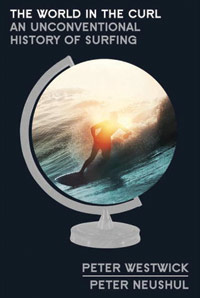The World in the Curl
An Unconventional History of Surfing
Despite being perhaps the most admired of all sports on-screen, surfing has been less fortunate when it comes to its books. (Of Sports Illustrated’s Top 100 Sports Books, none are about surfing.) UCSB professors Peter Westwick and Peter Neushul change this with The World in the Curl. The tome brings a broader context and a more thoughtful, analytic worldview than ever before to the exciting tale of how riding waves has become a hugely popular activity and an even more powerful icon. It’s an exhilarating trip through the curl of constant innovation that transformed the folkways of isolated Pacific islanders first into a tourist attraction, then a competitive professional sport, and finally a multibillion-dollar lifestyle industry.

Starting with the Polynesian watermen and women who migrated to Hawai’i in the 5th century, The World in the Curl follows the adventures of those brave enough to challenge the ocean’s power and the land’s prejudice in pursuit of waterborne stoke. It’s a long list, and the glory of this comprehensively researched volume is that no two surfers are alike. By digging deep in the backgrounds of such well known founding surfers as Duke Kahanamoku, the authors have recovered others who are more obscure, but just as important. George Freeth, for example, was the Hawaiian-born son of an Irish sailor and a native Hawaiian woman, and here he is credited with, among other things, inventing the angled mode of attack that defines modern surfing. Talk about game changers; after Freeth’s angle ride, the wave’s curl becomes the locus for more than a century’s worth of style, passion, and ongoing self-expression.
The book follows Freeth’s example by cutting across the wave of standard chronology with chapters devoted instead to topics explored thematically. It turns out that the “Waikiki Dream” of perfect beaches has depended on massive coastal engineering projects bringing in sand from as far away as California nearly since the Duke was a grom. The authors’ shared background in the history of science puts them in a perfect position from which to identify and explain these crucial moments when the ocean gets caught up not only in human leisure activities, but also in the profit motives of those who make these activities possible. As a result, the book touts the impact of several non-surfers on the sport, including May Rindge, the dogmatic steward of Malibu property rights who faced down the octopus of national rail and in the process created some of the world’s most valuable ocean-front real estate.
The value of The World in the Curl becomes most evident when the subjects it addresses are either overlooked or misunderstood. Board shapes come and go, but without a decent wetsuit, most of the world’s breaks would be out of season nearly all the time. In their excellent chapter on war and surfing, Westwick and Neushul break down the influence of the defense industry on the evolution not only of the modern wetsuit, which was invented by a physicist fresh off the Manhattan Project, but also on such contemporary surf-world staples as wave forecasting, fiberglass, nylon, and Styrofoam. Ultimately, the payoff for all the research and reasoning that went into this project should be a whole new conversation about our world today and the waves we rode getting to it.
4•1•1
The World in the Curl: An Unconventional History of Surfing by Peter Westwick and Peter Neushul (Crown Publishing) is available at area bookstores and Amazon.com.



